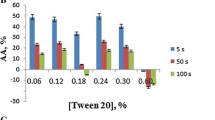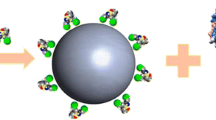Abstract
Physicochemical properties of Riboflavin (Vitamin B2) (RF), in Dextran 70 (Dx70) (a biological relevant glucidic type macromolecule) and Human Serum Albumin (HSA) (a carrier/transport protein) based system, have been studied by absorption, fluorescence, circular dichroism and electrochemistry. No significant changes on the fluorescence of RF in Dx70/HSA systems with and without the influence of temperature (30–60 °C range) were observed. No changes on the intrinsic Tryptophan fluorescence in Dx70/RF/HSA system, have been evidenced. HSA secondary structure when RF binds in Dx70/RF/HSA systems, with a renaturation effect of Dx70, was found. In Dx70/RF/HSA system the major process which RF undergoes is the proton transfer, Ered = −0.43 V. Using the chemiluminescence method, an improvement of the antioxidant activity of RF into the Dx70/RF/HSA system, was also found. RF concentration in Dx70/RF/HSA systems is important in RF oxidative damages when it reacts with target molecules and thus promotes their oxidation. The results have relevance in the oxidative stress process and in pharmaceutical formulations containing RF.








Similar content being viewed by others
References
Bensasson RV, Land EJ, Truscott TG (1983) Flash photolysis and pulse radiolysis in Biology and Medicine. Pergamon Press, Oxford
Massey V (2000) The chemical and biological versatility of riboflavin. Biochem Soc Trans 28:283–296
Peters T (1985) Serum albumin. In: In Advances in protein chemistry, vol 37. Academic Press, New York, pp 161–245
Carter DC, Ho JX (1994) Serum albumin: structure. In: In Advances in protein chemistry, vol 45. Academic Press, New York, pp 153–203
Sudlow G, Birkett DJ, Wade DN (1976) Further characterization of specific drug binding sites on human serum albumin. Mol Pharmacol 12:1052–1061
He XM, Carter DC (1992) Atomic structure and chemistry of human serum albumin. Nature 358:209–215
L.J. Kaplan, J.A. Kellum, Fluids, pH Ions and electrolytes, Curr Opin Crit Care, 16, 232–331, 2010
Taverna M, Marie A-L, Guidet B (2013) Specifiec antioxidant properties of human serum albumin. Ann Intensive Care 3:1–7
Carballal S, Radi R, Kirk MC, Barnes S, Freeman BA, Alvarez B (2003) Sulfenic acid formation in human serum albumin by hydrogen peroxide and peroxynitrite. Biochemistry 42:9906–9914
Cantin AM, Paquette B, Richter M, Larivée P (2000) Albumin-mediated regulation of cellular glutathione and nuclear factor kappa B activation. Am J Respir Crit Care Med 162:1539–1546
Quinlan GJ, Martin GS, Evans TW (2005) Albumin: biochemical properties and therapeutic potential. Hepatology 41:1211–1219
J. F. Robyt, Essentials of Carbohydr Chem, ed. J.F. Robyt, Springer, Ney-York, 1998; A. L. Bhavani, J. Nisha, Dextran - The polysaccharide with versatile uses, Int J Pharm Bio Sci, 1:569–573, 2010
M. Varrier, M. Ostermann, Fluid composition and clinical effect. In Nephrology – critical care clinics, Ed. J.A. Kellum, pp. 823–838, 2015
Voicescu M, Neacsu G, Beteringhe A, Craciunescu O, Tatia R, Moldovan L (2017) Antioxidant and cytotoxic properties of riboflavin in PEG/BSA systems. Chem Pap 71:1107–1117. https://doi.org/10.1007/s11696-016-0057-8
Whitmore L, Wallace BA (2008) Protein secondary structure analyses from circular dichroism spectroscopy: methods and reference databases. Biopolymers 89:392–400
Whitmore L, Wallace BA (2004) DICHROWEB: an online server for protein secondary structure analyses from circular dichroism spectroscopic data. Nucleic Acids Res 32:W668–W673
Lobley A, Whitmore L, Wallace BA (2002) DICHROWEB: an interactive website for the analysis of protein secondary structure from circular dichroism spectra. Bioinformatics 18:211–212
Compton LA, Johnson WC Jr (1986) Analysis of protein circular dichroism spectra for secondary structure using a simple matrix multiplication. Anal Biochem 155:155–167
Manavalan P, Johnson WC Jr (1987) Variable selection method improves the prediction of protein secondary structure from circular dichroism spectra. Anal Biochem 167:76–85
Sreerama N, Woody RW (2000) Estimation of protein secondary structure from CD spectra: comparison of CONTIN, SELCON and CDSSTR methods with an expanded reference set. Anal Biochem 287(2):252–260
Mao D, Wachter E, Wallace BA (1982) Folding of the H+-ATPase proteolipid in phospholipid vesicles. Biochemistry 21:4960–4968
Vasilescu M, Voicescu M, Lemmetyinen H, Meghea A (2004) The oxidative activity of riboflavin studied by luminescence methods. Rom J Biochem 41:51–63
Voicescu M, Ionita G, Constantinescu T, Vasilescu M (2006) The oxidative activity of riboflavin studied by luminescence methods: the effect of cysteine, arginine, lysine and histidine amino acids. Rev Roum Chim 51:683–690
Voicescu M, Ionita G, Vasilescu M, Meghea A (2006) The effect of cyclodextrins on the luminol-hydrogen peroxide chemiluminescence. J Incl Phenom Macrocyclic Chem 54:217–219
Voicescu M, Ionita G, Beteringhe A, Vasilescu M, Meghea A (2008) The antioxidative activity of riboflavin in the presence of antipyrine. Spectroscopic studies. J Fluoresc 18:953–959
Voicescu M, Ion R, Meghea A (2010) Evaluation of the oxidative activity of some free base porphyrins by a chemiluminescence method. J Serb Chem Soc 75:333–341
Teale FWJ, Weber G (1957) Ultraviolet fluorescence of the aromatic amino acids. Biochem J 65:476–482
Voicescu M, Heinrich M, Hellwig P (2009) Steady - state and time - resolved fluorescence analysis of tyrosine-histidine model compounds. J Fluoresc 19:257–266
Voicescu M, El Y, Khoury D, Martel M, Heinrich PH (2009) Spectroscopy analysis of tyrosine derivatives: on the role of the tyrosine - histidine covalent linkage in cytochrome c oxidase. J Phys Chem B 113:13429–13436
J. R. Lakowicz, Principles of Fluorescence Spectroscopy, 3rd ed.; Spinger, Berlin Heidelberg, Germany, 2006
Alam MM, Qais FA, Ahmad I, Alam P, Khan RH, Naseem I (2017) Multi-spectroscopic and molecular modelling approach to investigate the interaction of riboflavin with human serum albumin. J Biomol Struct Dyn 36:1–34. https://doi.org/10.1080/07391102.2017.1298470
Voicescu M, Angelescu DG, Ionescu S, Teodorescu VS (2013) Spectroscopic analysis of the riboflavin - serum albumins interaction on silver nanoparticles. J Nanopart Res 15:1555. https://doi.org/10.1007/s11051-013-1555-z
Memarpoor-Yazdi M, Mahaki H (2013) Probing the interaction of human serum albumin with vitamin B2 (riboflavin) and L-arginine (L-Arg) using multi-spectroscopic, molecular modeling and zeta potential techniques. J Lumin 136:150–159
Voicescu M, Ionescu S (2015) 3-Hydroxyflavone - bovine serum albumin interaction in dextran medium. J Serb Chem Soc 80(4):517–528
Froehlich E, Mandeville JS, Jennings CJ, Sedaghat-Herati R, Tajmir-Riahi HA (2009) Dendrimers Bind Human Serum Albumin. J Phys Chem B 113:6986–6993
Ahmed Ouameur A, Marty R, Tajmir-Riahi HA (2005) Human serum albumin complexes with chlorophyll and Chlorophyllin. Biopolymers 77:129–136
Voicescu M, Nistor CL, Meghea A (2015) Insights into the antioxidant activity of some flavones on silver nanoparticles using the Chemiluminescence method. J Lumin 157:243–248
Taverna M, Marie A-L, Mira J-P, Guidet B (2013) Specific antioxidant properties of human serum albumin. Ann Intensive Care 3:4. https://doi.org/10.1186/2110-5820-3-4
Gutteridge JM (1986) Antioxidant properties of the proteins caeruloplasmin, albumin and transferrin. A study of their activity in serum and synovial fluid from patients with rheumatoid arthritis. Biochim Biophys Acta 869:119–127
Roche M, Rondeau P, Singh NR, Tarnus E, Bourdon E (2008) The antioxidant properties of serum albumin. FEBS Lett 582:1783–1787
Kawakami A, Kubota K, Yamada N, Tagami U, Takehana K, Sonaka I, Suzuki E, Hirayama K (2006) Identification and characterization of oxidized human serum albumin. A slight structural change impairs its ligand-binding and antioxidant functions. FEBS J 273:3346–3357
Acknowledgements
This work was done within the research programme “Quantum Chemistry and Molecular Structure” of the Institute of Physical Chemistry “Ilie Murgulescu” of the Romanian Academy.
Author information
Authors and Affiliations
Corresponding author
Ethics declarations
Conflict of Interest
None.
Rights and permissions
About this article
Cite this article
Voicescu, M., Ionescu, S. & Lete, C. Physicochemical and Antioxidant Properties of Riboflavin in Dextran70/HSA Systems. J Fluoresc 28, 889–896 (2018). https://doi.org/10.1007/s10895-018-2251-2
Received:
Accepted:
Published:
Issue Date:
DOI: https://doi.org/10.1007/s10895-018-2251-2




